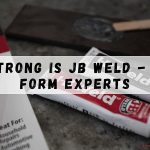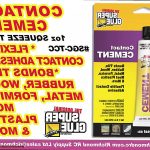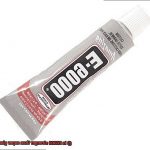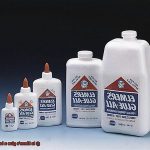Ever wondered if contact cement is really as permanent as they claim? Well, you’re in luck because we’re about to dive deep into the world of adhesives and uncover the true staying power of contact cement.
Whether you’re tackling a home improvement project, getting your craft on, or just plain curious about the reliability of this popular adhesive, we’ve got you covered. In this blog post, we’ll explore the ins and outs of contact cement – its characteristics, applications, and limitations – so you can decide if it’s the right choice for your next endeavor.
So grab your favorite cup of joe, kick back, and let’s dig into whether contact cement truly lives up to its permanent reputation.
What is Contact Cement?
Contents
- 1 What is Contact Cement?
- 2 What are the Properties of Contact Cement?
- 3 Is Contact Cement Permanent?
- 4 Factors Affecting the Permanence of Contact Cement
- 5 Types of Materials Suitable for Bonding with Contact Cement
- 6 Application Technique and Drying Time for Contact Cement
- 7 Conditions Impacting the Permanence of Contact Cement
- 8 Conclusion
With the ability to create an instant and unyielding bond between different materials, this adhesive has become a favorite in construction and woodworking projects. In this guide, we will delve into the world of contact cement, exploring its composition, application techniques, and wide-ranging applications.
Composition and Characteristics:
Contact cement is typically composed of solvents, rubber polymers, and resins. The solvents keep the adhesive in a liquid state, allowing for easy application. However, it is important to note the flammability and toxicity of these solvents, making proper ventilation and safety precautions crucial when working with contact cement.
One of the defining characteristics of contact cement is its ability to form an enduring bond. Once the adhesive is applied and surfaces are joined together, separation becomes difficult without causing damage. This durability makes contact cement perfect for projects that require a long-lasting connection.
Application Techniques:
To achieve optimal results with contact cement, even application and drying time are crucial. Begin by applying a thin layer of adhesive to both surfaces using a brush or roller. Ensure that the adhesive is spread evenly across the entire surface.
After application, allow the adhesive to dry for the recommended time. This allows the solvents to evaporate, leaving behind a tacky film on both surfaces. When the adhesive feels tacky to the touch, firmly press the surfaces together with care. The bond will be instantaneous, so accurate alignment is essential before joining them.

Applications:
The versatility of contact cement makes it suitable for a wide range of applications. Here are some common uses:
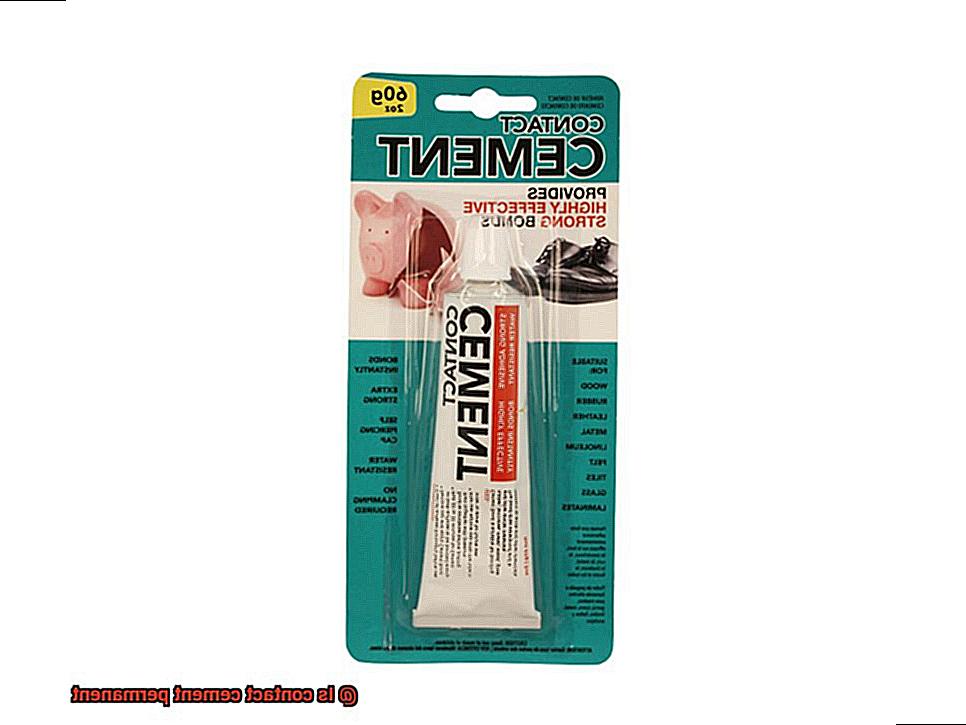
- Laminating Countertops: Contact cement excels in attaching laminate sheets to countertops, creating a seamless and durable finish.
- Veneer Bonding: Contact cement provides a strong bond for attaching veneer to furniture, giving it an elegant and polished appearance.
- Leather and Fabric Bonding: Whether repairing shoes, upholstering furniture, or creating crafts, contact cement is excellent for bonding leather or fabric to other materials.
What are the Properties of Contact Cement?
Let’s explore what makes contact cement so special and why it should be considered for your next project.
- Instant Bonding: Unlike other adhesives that require drying time or clamping, contact cement creates an immediate bond upon contact. This means no waiting around for glue to dry – you can join your materials together and move on to the next step right away. Whether you’re working on time-sensitive projects or simply want to save time, contact cement has got you covered.
- High Strength: Contact cement forms a strong and durable bond that can withstand heavy loads and stress. It’s perfect for applications where a long-lasting and reliable bond is essential. Whether you’re laminating countertops or attaching veneers to furniture, contact cement ensures a bond that stands the test of time.
- Heat Resistance: Contact cement exhibits excellent heat resistance, making it suitable for use in high-temperature environments. It won’t lose its adhesive properties or break down when exposed to heat, making it ideal for kitchen projects or areas near hot appliances.
- Flexibility: Once cured, contact cement remains flexible, allowing for slight movements and expansions without compromising the bond. This flexibility makes it perfect for bonding materials that may experience changes in temperature or slight movements over time.
- Moisture and Chemical Resistance: Contact cement is highly resistant to moisture, water, oils, solvents, and other common household chemicals. This means that even in environments with high humidity or exposure to chemicals, your bonded materials will stay intact.
- Versatility: Contact cement has excellent adhesion to a wide range of materials including wood, metal, plastic, leather, fabric, and more. Whether you’re working on a woodworking project or repairing your favorite pair of shoes, contact cement can bond different types of materials together with ease.

Is Contact Cement Permanent?
Imagine a bond so unbreakable, it could withstand the test of time. That’s the promise of contact cement, the adhesive superhero that claims to be permanent. But does it truly live up to its invincible reputation? Let’s dive into the world of contact cement and uncover the truth.
Contact cement is renowned for its strong bond and durability. When applied correctly, it forms a permanent connection between two surfaces. But how does it achieve this remarkable feat? It all comes down to chemistry. As the solvent in contact cement evaporates, a chemical reaction occurs, leaving behind a robust adhesive layer. This unique process sets contact cement apart from ordinary glues that simply dry or cure.
However, there’s a catch. To unleash the full power of contact cement, both surfaces need to be coated with the adhesive and allowed to dry before joining them together. This is because contact cement creates its formidable bond by adhering to itself, rather than just sticking to the surfaces. Rushing through this crucial step will result in a weak bond that won’t stand the test of time.
Now, let’s address the elephant in the room – is contact cement truly permanent in all cases? Well, it depends on several factors.
Firstly, the materials being bonded play a significant role. Contact cement excels at bonding materials like wood, metal, and laminate. However, it may not be as effective on porous surfaces such as fabric or certain plastics. If you’re working with unconventional materials like foam or nylon, alternative adhesives might be more suitable.
The quality of the contact cement used is another factor to consider. Like any superhero team-up, not all contact cements are created equal. Different brands and formulations vary in durability and longevity. To ensure optimal results, always select high-quality contact cement that matches your specific project requirements.
The application process also impacts the permanence of contact cement. Carefully read and follow the manufacturer’s instructions. Proper coverage and drying time are essential for a strong and long-lasting bond. Rushing through application or neglecting sufficient drying time will result in a weaker bond that won’t withstand the test of time.
But let’s say you’ve done everything right, and your bond has held firm for years. Is contact cement truly permanent then? Well, not exactly. In some cases, contact cement can be removed or softened using solvents like acetone or mineral spirits. However, this process can be time-consuming and may damage the bonded materials. While contact cement may not be completely indestructible, it is certainly a formidable force to reckon with.
In conclusion, contact cement is generally considered permanent, but its permanence can vary depending on factors such as the materials being bonded, the quality of the adhesive, and the application process. To ensure a bond that stands the test of time, choose the right type of contact cement for your project, diligently follow instructions, and provide sufficient drying time for it to work its magic.
Factors Affecting the Permanence of Contact Cement
Today, we embark on a deep dive into the intricate world of contact cement, exploring the factors that can affect the permanence of its bonds. So grab your adhesive and prepare to be stuck in awe.
First and foremost, let’s talk about surface preparation. Picture this: you’re trying to forge a solid bond with contact cement, only to discover that the surfaces you’re working with are covered in a treacherous layer of dust, grease, or oil. Oh no. The key to a strong and long-lasting bond lies in properly preparing the surfaces. They must be meticulously clean, dry, and free from any contaminants that could sabotage the bonding process.
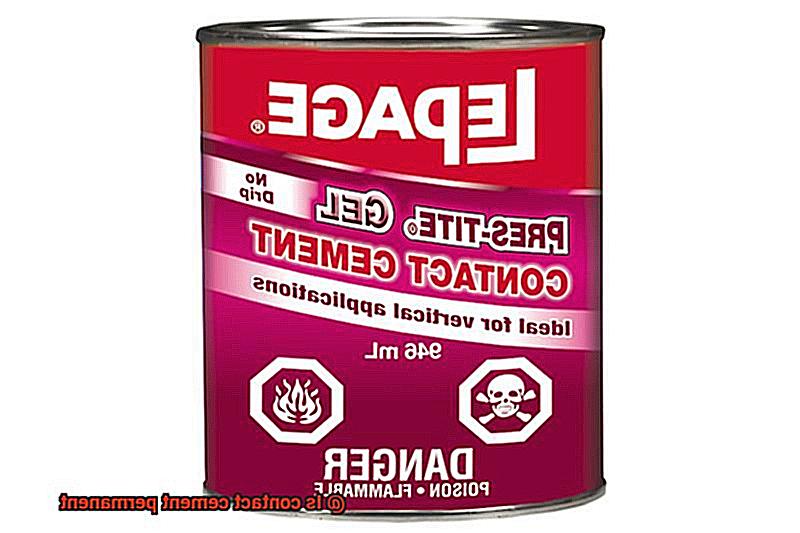
Next up on our agenda is application technique. Like a master chef following a recipe to the letter, it is crucial to adhere (pun intended) to the manufacturer’s instructions when applying contact cement. They hold the secret formula for success, specifying the ideal thickness and coverage required to achieve optimal results. Applying too little or too much adhesive can throw off the delicate balance necessary for a secure bond. And don’t forget to strive for even coverage across both surfaces to forge an unbreakable connection.
Now, let’s discuss the concept of drying time. Patience truly is a virtue here. Hastening the process by joining the surfaces prematurely can jeopardize the permanence of the bond. Allow your contact cement ample time to dry and reach its full bonding strength. The recommended drying time varies depending on factors such as temperature and humidity, so take a moment to consult those instructions once more.
Temperature and humidity conditions also wield significant influence over the permanence of contact cement bonds. Extreme temperatures or excessive humidity levels can impede the drying process and weaken the bond. Stay within the manufacturer’s recommended temperature range and work in an environment with controlled humidity levels for optimal bonding conditions.
Last but certainly not least, let’s ponder material compatibility. Just like people, some materials are inherently more compatible than others. Before diving headfirst into your project, double-check if your chosen contact cement is suitable for bonding the specific materials you’re working with. Certain materials may require special primers or surface treatments to enhance adhesion. Using an incompatible adhesive can result in lackluster bonding and reduced permanence, which is a true glue conundrum.
Types of Materials Suitable for Bonding with Contact Cement
This adhesive is a true magician when it comes to bonding different materials together. In this exploration, we will discover the types of materials that can be magically bonded using contact cement. So, roll up your sleeves and let us embark on this enchanting journey.
Wood: The Darling of Contact Cement:
Wood, the trusty companion of contact cement, takes center stage in our first act. Whether you’re crafting furniture or creating beautiful wooden objects, contact cement is the go-to adhesive. Its strong and dependable bond withstands the test of time. With contact cement, building desks or repairing chairs becomes a seamless endeavor.
Laminate: Stick Together, Stay Together:
Prepare to be amazed by the secret ingredient that keeps those sleek laminate countertops in place – contact cement. This adhesive creates an unbreakable bond between laminate sheets and their underlying surface. Impress your guests with stunning kitchen countertops held firmly together by the magic of contact cement.
Leather: Bonding in Style:
Calling all leather lovers. Contact cement is here to save the day when it comes to repairing your favorite leather items or embarking on new leather projects. Remember to clean both surfaces before applying contact cement for a flawless bond. With contact cement as your trusty sidekick, your leather creations will remain strong and stylish.
Rubber and Plastic: Sticking It Out:
Don’t be fooled by the trickiness of bonding rubber and plastic – contact cement makes it a breeze. Fixing weatherstripping on your car or attaching molding becomes a stress-free experience with this reliable and flexible bond. Just ensure that your specific rubber or plastic is compatible before delving into your project.
Metal: When Welding Isn’t an Option:
When traditional welding or soldering isn’t feasible or desired, contact cement swoops in to save the day. While not as commonly used for metal bonding, it works wonders for lightweight applications or decorative purposes. Remember to prep those metal surfaces before applying contact cement, and watch as they magically bond together.
Application Technique and Drying Time for Contact Cement
Contact cement is a versatile adhesive that can be used in a variety of applications, from woodworking to leatherworking. To ensure a strong and lasting bond, it is important to follow proper application techniques and understand the drying time of contact cement.
Firstly, before applying contact cement, it is crucial to prepare the surfaces that will be bonded. These surfaces should be clean, dry, and free from any dust or debris. A thorough cleaning with mild detergent and allowing them to dry completely will ensure optimal adhesion. Think of it like preparing a canvas before painting – you want a clean slate to work with.
Once the surfaces are prepped, it’s time to apply the contact cement. Thin is the name of the game here. Applying a thin layer of contact cement ensures a stronger bond and prevents any excess adhesive from ruining your project. You can use a brush or roller to apply the adhesive evenly on both surfaces. For an even stronger bond, consider applying multiple thin coats with sufficient drying time in between. This allows each layer to fully adhere before adding the next.
Now comes the waiting game – drying time. The drying time for contact cement can vary depending on factors such as temperature and humidity. It’s important not to rush this step. Allow the adhesive to dry for at least 15 minutes to an hour before joining the surfaces together. To test if the contact cement is ready for action, lightly touch it with your fingertip. If it feels tacky but doesn’t stick to your finger, it’s good to go. However, if it’s still wet or sticky, give it more time to dry.
Conditions Impacting the Permanence of Contact Cement
Imagine the frustration of seeing your meticulously crafted masterpiece fall apart due to a weak bond. That’s where contact cement comes in. Renowned for its ability to create strong bonds between various materials like wood, metal, and plastic, contact cement’s permanence can be impacted by several key factors. Let’s delve into the intricate details to ensure your projects endure the test of time.
Surface Preparation:
Before applying contact cement, thorough surface preparation is crucial. Cleanliness, dryness, and freedom from contaminants are essential for a lasting bond. Dust, grease, or moisture can undermine bonding strength and decrease longevity. Remember, a solid foundation is paramount to achieving a resilient bond.
Compatibility Matters:
The nature of the surfaces being bonded plays a pivotal role in determining permanence. While contact cement generally works well with a variety of materials, it is wise to consult the manufacturer’s guidelines or conduct a small compatibility test. Better to be safe than sorry.
Environmental Conditions:
Ah, Mother Nature. She can significantly impact adhesive bonds. Extreme temperatures, high humidity levels, and exposure to sunlight all influence contact cement’s performance. Excessive heat may cause softening or melting, while extreme cold can result in brittleness and cracking. Shield your projects from temperature extremes for maximum permanence.
Application Techniques:
Proper application techniques are essential for establishing a strong and enduring bond. Carefully follow the manufacturer’s instructions, ensuring an even application on both surfaces. Pressing the surfaces firmly together immediately after applying the adhesive maximizes contact and bonding strength.
Drying and Curing Time:
Patience is indeed a virtue. Allow sufficient time for the adhesive to dry and cure adequately before subjecting it to stress or load. Rushing this process compromises bond strength and reduces permanence. Remember, good things come to those who wait.
Know the Limits:
While contact cement is an exceptional adhesive, it may not be suitable for all applications. Some materials or environments require specific adhesives that offer flexibility or resistance. In such cases, opt for an adhesive specifically formulated to meet those requirements. Don’t force a square peg into a round hole.
LyF134qG_ys” >
Conclusion
In conclusion, contact cement is widely acknowledged as a formidable adhesive that boasts permanence. When applied with precision and used on materials that harmonize well, it forges an unyielding and enduring bond capable of bearing substantial loads, enduring temperature fluctuations, and withstanding exposure to moisture and chemicals. Nonetheless, the degree of permanence can fluctuate depending on various factors.
Prudent preparation of the surface is pivotal in achieving a robust connection. Prior to application, surfaces must be immaculate, devoid of moisture, and uncontaminated by foreign substances. Furthermore, employing top-notch contact cement that aligns seamlessly with the specific demands of the project is crucial for optimal outcomes.
The technique employed during application and the duration required for drying also wield considerable influence over the longevity of the bond. Adhering faithfully to the manufacturer’s guidelines regarding application technique and allowing ample drying time are indispensable measures in securing a resolute and long-lasting union.
It is important to acknowledge that while contact cement typically offers permanence, it may not be universally suitable for all materials or applications. Certain materials such as fabric or select plastics may not form bonds as effectively with contact cement. In such instances, alternative adhesives may prove more compatible.
All things considered, when utilized judiciously on appropriate materials, contact cement bestows an indelible bond that endures through time’s relentless test. This versatile adhesive exhibits extraordinary strength, imperviousness to heat and chemicals, flexibility, and resistance to moisture.


